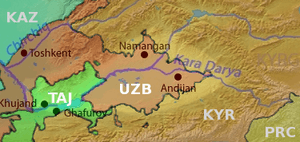Ferghana Valley
The Ferghana Valley (also transliterated as Fergana or Farghana) is historically the main Silk Road route between Kashgar and Samarkand. It is a relatively fertile, populous and prosperous area though much of the surrounding country is mountains, steppe or desert. Two rivers, the Naryn and the Kara Darya, flow into it from the east and merge to form the Syr Darya which runs through most of the valley and out to the west.
The region has a long and rather tumultuous history. Alexander the Great took part of it in the 4th century BCE and the Graeco-Bactrian kingdom he founded ruled the area for a few centuries after that; the Syr Darya, then known as the Jaxartes, was the northern border of their territory. Alexander founded Alexandria Eschate (furthest Alexandria) in the region to protect his border; the city still exists as Khujand.
For much of its history, the region was part of various Persian Empires, at their northeastern border. Genghis Khan conquered it in the 13th century and his descendant Tamerlane ruled it in the late 14th. Babur — who founded the Mughal dynasty that ruled much of the Indian subcontinent for centuries — was the son of the valley's ruler, and a great-great grandson of Tamerlane. In the 19th and 20th centuries the region was part of the Russian Empire and the Soviet Union.

Today the valley is split by political borders; the modern countries of Kyrgyzstan, Tajikistan and Uzbekistan each have part of it. These are covered in the following articles (listed East-to-West):
There are a number of cities in the valley, all with a history as Silk Road trading centres. East-to-West the main ones are:
In the 19th century the valley and surrounding areas were taken by the Russian Empire and they were part of the Soviet Union until the 1990s. Russian is still a very important language in the area; several others are spoken by the different ethnic groups, but Russian often serves as the lingua franca for communication between groups.